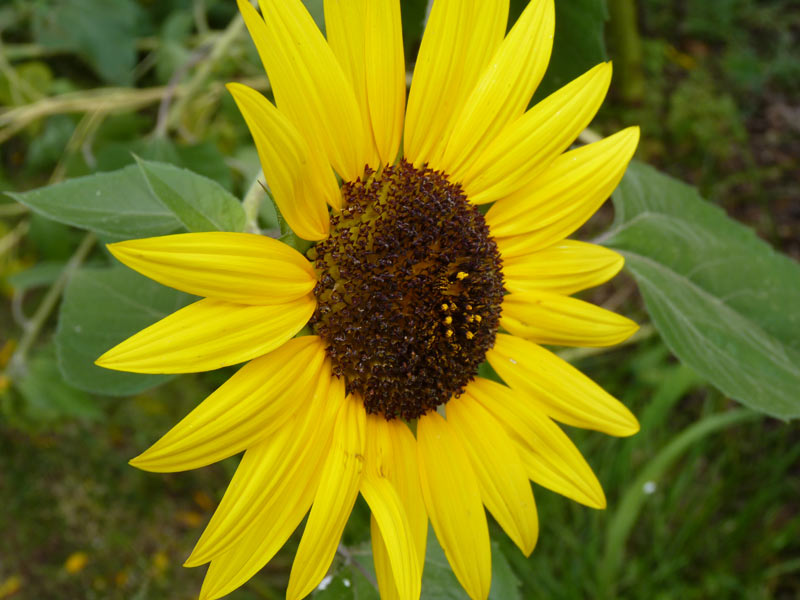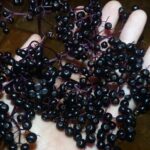In druidry and in other earth-centered religions, its customary to make offerings to spirits, the ancestors, guides, outsiders, etc. We usually do this as part of ritual or solitary practice. Recently, the issue of what to use as offerings came up in a discussion in one of my druid groups, and I’d like to spend some time thinking about this practice and its connection to sustainability and earth-centered living.
Why offerings? Offerings are usually made in honor of deities, ancestors, spirit guides, spirits of the land, the earth mother herself, etc. I often leave small offerings on natural altars that I maintain, as well as use them at the start of rituals to show gratitude and thanks. A simple offering might be a plate of cakes left to honor the land for a bountiful harvest, a handful of seeds cast out of a sacred space to keep the outsiders outside, or wine poured onto the fire. Offerings that druids and other earth-centered/pagan practitioners provide vary widely, but commonly you see wine, mead, apples, tobacco, honey, baked goods, silver coins, herbal blends, and so forth.

Where does that offering come from? I think that *what* the offering consists of is usually given a lot of thought in our practices. You can Google information on offerings, or read any earth-based or pagan-focused book, and they all talk about the appropriateness of various offerings. The problem with this approach is that it often ignores the system from which that offering comes. I’d like to propose that, if we want to encourage a sustainable mindest, then druids and other earth-centered practitioners might also want to think carefully about *where* their offerings come from. If we are offering that comes out of the general polluting consumerist system, that offering will reflect polluting/consumerist energy, regardless of what intention that you put into offering it.
Take, for example, the humble bottle of wine you pick up at the supermarket for your next ritual. The supermarket bottle of ritual wine has three potential issues associated with it.
1) The physical production and transport of the simple bottle of ritual wine has a network of various energies, resources, and pollution tied up in it. Where does the wine come from? Who produced it? How were the grapes grown and processed? How many pesticides were used? How far did it have to travel and how many fossil fuels were burnt on that trip? Chances are, that supermarket bottle of wine is part of the larger consumptive system and has damaged the planet in some way (from pesticide use to the CO2 and other chemicals emitted with its transport). Is this the offering you want to make to the spirit realm?
2) The spiritual energies associated with the supermarket bottle of wine. How many other people handled it before you? What other energies might be present? How do those energies interfere with your intentions? Again, is this the offering you want to be making to the spirit realm?
3) The final issue is internal to you–your intentions and energy expended in getting the offering. By doing something so effortless as grabbing a wine off the shelf, paying for it, and uncorking it for your offering, is this really an offering? What exactly is an offering? An offering should be meaningful, it should demonstrate your commitment and sincerity. The effort involved in purchasing something is quite minimal. Is this what you want to be conveying to the spirit realm?
I think that for those of us who have lived our whole lives in consumerist society, going to the store and purchasing a bottle of wine doesn’t really seem like an issue. Its something we don’t even think about–we need an offering, so we go buy one. But not thinking about these issues is exactly what has gotten us into our current unsustainable situation. Instead, I propose that we put more thought and effort into what we use as an offering.
Sustainable, Meaningful Offerings
To address the three problematic areas above, I’d like to propose two solutions: making earth-centered offerings and offering lifestyle changes instead of physical goods.

Making earth-centered offerings. Rather than purchasing offerings, I’d like to suggest that you can grow your own offerings or gathering them from natural spaces (recognizing and respecting any rules about gathering from state parks, of course). Naturally grown, earth centered offerings have the benefit of being something that wildlife will likely eat as well as not being part of the damaging, consumptive system that is slowly killing the non-human life on this planet. Everyone has the ability to gather, even if you have no space to grow.
You’d be surprised what you can grow and/or gather. Seeds and nuts are wonderful choices for growing or gathering, and they store quite well. I grow my own sunflowers, amaranth, broom corn, as well as collect acorns, walnuts, and other assorted nuts; many of these become offerings. A squirrel is sure to appreciate some black walnut, hickory, or acorns left on a Yule or Imbloc altar! I also occasionally make my own cakes with something I’ve grown or gathered–acorn flour, sunflower seeds, etc. For the cakes, I also have purchased rye and wheat from local farmers who are engaging in sustainable practices, since I don’t have the space to grow much of that here on my small property. The intention and the energy that goes into growing or gathering something will really be appreciated in the spirit realm!
For offerings that I plan on casting into the fire, I make it a point to create an all-local, sustainable fire blend. When we prune our cedars, I dry out the branches and needles (which make wonderful cracking and popping when you throw them into the fire. I also collect and dry juniper berries, rose hips, and sap from conifers on our property that has dripped and dried. Pine needles and pine cones are added to the blend and the result is a wonderfully smelling and quick burning offering. I mixed this up in a big bucket a few years ago and gave some to my grove members in a small cloth bag.
I’ve also offered handfuls of composted manure to the spirits of the land. For this, I went and got the manure from local herds of alpacas or horses, composted it down, and then offered it in thanks. This was a really nice “harvest” offering to our land for the bountiful season. This offering is quite amazing because it directly provides fertile soil for the land in which to grow.
If you have space, you can also make permanent kinds of offerings–planting trees, shrubs, and flowers that will aid wildlife and tending them till they are grown. For this purpose, I’ve planted service berry, a butterfly/bee garden, and engage in other permaculture-based practices. Just make sure your offerings are native and fit the landscape if they are going to be left :).
Your own lifestyle as an offering. The second thing I’d like to propose is that offerings don’t have to be physical. They can be lifestyle changes. Consider, for example, the impact you’d make if each year, as part of your spiritual path, you committed to engaging in one more earth-centered practice. This could be something quite simple, from starting a recycling program in your office to serving as a volunteer in your community on environmental projects. Earth-centered offerings might also be participating in a backyard wildlife project where you aid scientists in tracking the migration of species to something more radical, like committing to grow 50% of your food for the year. Each time you do this, you offer more than just a physical object–you offer your time and energy to improving and preserving the world. What greater offering can there be?



This is a wonderful posting, Dana. In many ways, it puts into practice so much of the spirituality that is often discussed without doable specifics.
On a more academic note, your reflection on the bottle of wine reminds me actor-network theory. Nice to see it making its way into druidry!
Thanks for sharing it.
Thanks Jeffrey. I’m not familiar with actor-network theory; I’ll have to take a look at it! 🙂
Unless you mean actor-oriented theory (aka Activity theory)? If so, I’m quite familiar with it because of my own research on transfer of learning :).
Great topic! I just found your blog, and it’s nice to hear from a pagan who thinks about these things deeply.
I’ve been thinking about offerings a lot lately, as we’ve moved to a new piece of land and my typical offerings (garden produce) don’t seem to fit. And I don’t have a garden yet. 🙂 I was stymied with the idea of leaving seeds for two reasons: One of my perennial (har) concerns is accidentally introducing invasive species, so that takes a lot of care to make sure the thing I offer isn’t going to literally take on a life of its own. (This is true of water and soil as well as seeds.) I was also pondering that leaving acorns, pretty stones, etc. on the land where I gathered them is sort of like cutting a friend’s hair and giving it back to her!
It did occur to me that crafting items of natural materials has enough of “me” in it to feel like a good offering, yet is natural enough not to pollute. Twigs, grasses, beeswax, local clay all seem like they could be good materials.
Emily, so nice to hear from you! And you are just down the road from me, so to speak :).
You might think about other offerings, such as maintaining a permanent shrine in thanks (I talk about this here: http://druidgarden.wordpress.com/2012/09/21/building-outdoor-sacred-spaces-part-iii-other-small-projects/)
Down here in the Caribbean, I love buying a bottle of local rum to use for this. There are also tons of flowers that grow in hedges and such that work for decorating an outdoor altar or stone pile. I can’t wait until I move into my new apartment an I can begin growing my own garden.
Love it!
a thousand times, amen
Fifteen years ago I decided to start converting a section of my woodland at the top of my property around an old 1800’s cellar hole to a native plant sanctuary. It would be my way of offering new life for the land , and restoring native plants, herbs, and wildflowers. I was already a member of United Plant Savers, and I had studied what native plants (should) grow in the woodlands of my area of west central NH. Some common native plants I knew, others had become rare or at-risk because of destruction of habitat from land development. I also went around our land to do an inventory of what was already growing in our woods. I obtained seeds and plants from United Plant Savers, carefully collected seeds, and took some root cuttings from some of the plants growing on our land, got rescued plants from constructions sites, and purchased some as my budget allowed over the years from ethical growers. As of this Spring I have colonies of native plants establishing in the area I tended all these years. There are now large drifts of Bloodroot, Black Cohash , Mayapples, Wild Ginger, Maidenhair ferns, Jack in the Pulpits, Solomon’s Seal, and some smaller colonies of Trilliums, Blue Cohash, Goldenseal, wild dwarf Iris, Partridge Berry, Red Cardinal Flower, and Uva Ursi (Bear berry). I have also planted bushes and trees as part of my permaculture plantings: Aralia, Hawthorn trees, Elderberries, a Witchhazel, ‘Liberty’ and ‘Freedom’, the 2 new Apple trees that are disease resistant and do not need to be sprayed. I turned a small meadow back over to Milkweed, Asters, Goldenrod and a hedgerow of Sycamore trees. for birds, bees, pollinators, and butterflies. In the future I hope to plant Blueberries, wild Plum, and I just obtained a vine called a Goji Berry. I also have a large herb garden of culinary and medicinal herbs and make herbal medicines for people in need, incense for offerings, and grow flowers for offerings. I grow hundreds of herbs that are loved by the bees. Tending the gardens, and teaching others is my life’s work since I retired seven years ago. In a way my daily life has become part of my offerings besides the more formal devotions and rituals I do as a Druid member of ADF. — niniann lacasse
This is a wonderful story–thank you for sharing. I’d love to see photos if you have them posted anywhere online. It sounds like a santuary for all life!
There are several photos @ http://www.lacassep.byregion.net
— niniann
Wow, those are beautiful! Thank you for sharing!
Reblogged this on Rattiesforeverworldpresscom.
Thank you for the reblog!
You re welcome 🙂